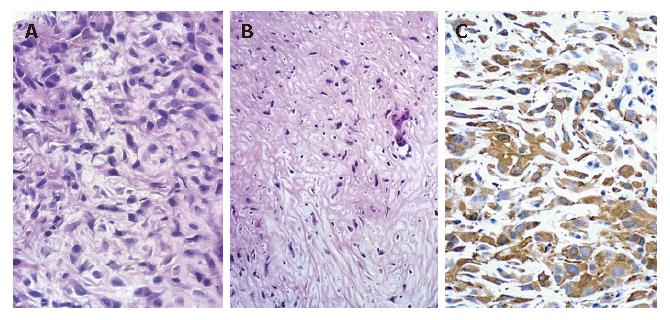Copyright
©2007 Baishideng Publishing Group Co.
World J Gastroenterol. Feb 7, 2007; 13(5): 809-812
Published online Feb 7, 2007. doi: 10.3748/wjg.v13.i5.809
Published online Feb 7, 2007. doi: 10.3748/wjg.v13.i5.809
Figure 1 Magnetic resonance imaging showing hypointense areas in the right lobe of the liver on a T1-weighted image (A) and an inhomogeneously hyperintense mass on a T2-weighted image (B).
Figure 2 Needle biopsy showing a sarcomatous area consisting of interlacing bundles of atypical spindle cells [hematoxylin-eosin stain; magnification x 200 (A), x 100 (B)] and immunohistochemical staining showing positive α-SMA (C).
Figure 3 Gross appearance of hepatic tumor.
Figure 4 Spindle cells (A), pleomorphic areas (B), or hyalization (C) in leiomyosarcoma (hematoxylin-eosin stain; magnification x 160).
Figure 5 Cholangiocarcinoma focus (A) (hematoxylin-eosin stain; magnification x160), component surrounded by fibrosis (B) (hematoxylin-eosin stain; magnification x100), intimately mixed carcinomatous and sarcomatous components (C) (hematoxylin-eosin stain; magnification x 160).
Figure 6 Sarcomatous portion of the tumor consisting of undifferentiated (embryonal) sarcoma [hematoxylin-eosin stain; magnification x 25 (A, B), x 160 (C)].
- Citation: Sumiyoshi S, Kikuyama M, Matsubayashi Y, Kageyama F, Ide Y, Kobayashi Y, Nakamura H. Carcinosarcoma of the liver with mesenchymal differentiation. World J Gastroenterol 2007; 13(5): 809-812
- URL: https://www.wjgnet.com/1007-9327/full/v13/i5/809.htm
- DOI: https://dx.doi.org/10.3748/wjg.v13.i5.809














